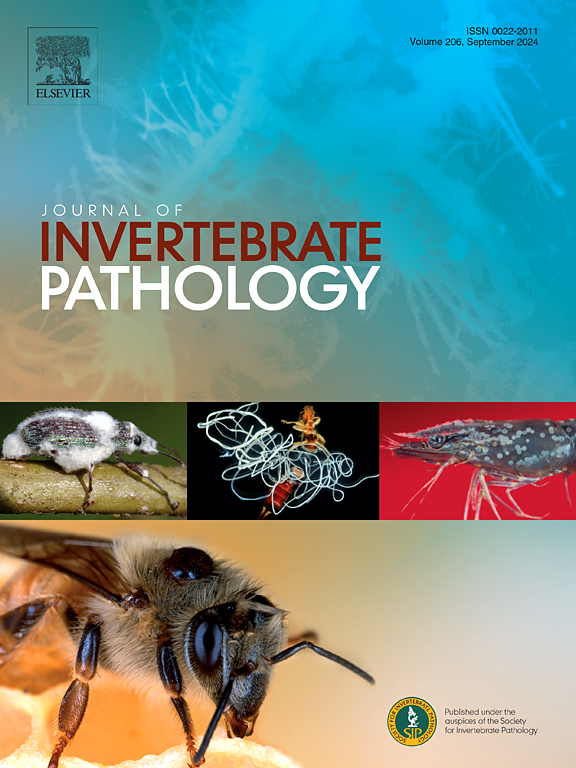A new aphid IPM strategy based on the use of endophytic entomopathogenic ascomycetes that reduces treatment risks to the generalist predator Chrysoperla carnea (Stephens)
IF 2.4
3区 生物学
Q1 ZOOLOGY
引用次数: 0
Abstract
The melon aphid Aphis gossypii is one of the most damaging and economically important crop pests. Entomopathogenic ascomycete (EA) have shown great potential in managing this pest, with several mycoinsecticides available on the market. Recent studies also highlight the systemic efficacy of EA endophytic strains, targeting aphids through the plant and impacting their survival and reproduction.
EA endophytic application prevents direct contact between EA and beneficial insects which increases their safety. Indeed, EA endophyte compatibility with other biological control agents, such as entomophagous predators, has been demonstrated under laboratory conditions. However, these results need to be validated using different application methods and under greenhouse conditions. In this study, we evaluated the biocontrol potential of two endophytic EA strains against A. gossypii in melon crops under greenhouse conditions. Based on their known endophytic behavior, Metarhizium brunneum strain EAMa 01/58-Su was applied as a foliar spray while Beauveria bassiana strain EABb 01/33-Su was applied as a seed dressing. Furthermore, the compatibility of these EA applications with the predator Chrysoperla carnea was assessed. Two repetitions were made in a greenhouse in Córdoba (Spain), the first in summer and the second in autumn. It is noteworthy that, in summer, foliar spraying with M. brunneum resulted in 35.0 % aphid mortality and a 20.4 % reduction in total per capita nymph production (TCNP) on sprayed leaves. In contrast, leaves not sprayed with the fungal suspension but endophytically colonized caused 70.0 % aphid mortality and a 12.6 % reduction in TCNP, which demonstrates the systemic potential of this fungus. Compatibility between C. carnea and M. brunneum was also demonstrated; there was a significant increase in prey consumption on endophytically-colonized leaves compared with predation levels observed in control plants. Seed dressing with B. bassiana led to 55.0 % aphid mortality and a 19.2 % reduction in TCNP but had no significant effect on C. carnea predation. The same trends were observed in autumn, although colder temperatures reduced aphid mortality. Our results highlight the potential of fungus-predator biocontrol strategies within an aphid Integrated Pest Management program under greenhouse conditions.

一种基于内生昆虫病原子囊菌的新型蚜虫IPM策略,降低了对多面手捕食者Chrysoperla carnea的治疗风险。
瓜蚜(Aphis gossypii)是危害最严重、经济最重要的作物害虫之一。昆虫病原子囊菌(EA)在控制这种害虫方面显示出巨大的潜力,市场上有几种真菌杀虫剂。最近的研究也强调了EA内生菌株的系统性功效,通过植物靶向蚜虫并影响它们的生存和繁殖。EA的内生应用防止了EA与益虫的直接接触,提高了它们的安全性。事实上,EA内生菌与其他生物防治剂(如食虫性捕食者)的相容性已在实验室条件下得到证实。然而,这些结果需要在不同的施用方法和温室条件下进行验证。在温室条件下,研究了两株内生EA菌株对棉蚜的生物防治潜力。根据已知的内生行为,采用绿僵菌EAMa 01/58-Su作为叶面喷雾,球孢白僵菌eab01 /33- su作为种子涂布。此外,还评估了这些EA应用程序与捕食者Chrysoperla carnea的兼容性。在Córdoba(西班牙)的温室中进行了两次重复实验,第一次在夏季,第二次在秋季。值得注意的是,在夏季,叶面喷施褐毛霉的蚜虫死亡率为35.0%,喷施叶片的人均若虫产量(TCNP)降低了20.4%。相比之下,未喷洒真菌悬浮液但内生定殖的叶片蚜虫死亡率为70.0%,TCNP降低12.6%,显示了该真菌的系统潜力。此外,还证实了木霉与褐毛霉的相容性;与对照植物的捕食水平相比,对内生定殖叶片的捕食量显著增加。球孢白僵菌处理后蚜虫死亡率为55.0%,TCNP降低19.2%,但对线虫捕食率无显著影响。在秋季也观察到同样的趋势,尽管较冷的温度降低了蚜虫的死亡率。我们的研究结果强调了在温室条件下蚜虫综合虫害管理计划中真菌-捕食者生物防治策略的潜力。
本文章由计算机程序翻译,如有差异,请以英文原文为准。
求助全文
约1分钟内获得全文
求助全文
来源期刊
CiteScore
6.10
自引率
5.90%
发文量
94
审稿时长
1 months
期刊介绍:
The Journal of Invertebrate Pathology presents original research articles and notes on the induction and pathogenesis of diseases of invertebrates, including the suppression of diseases in beneficial species, and the use of diseases in controlling undesirable species. In addition, the journal publishes the results of physiological, morphological, genetic, immunological and ecological studies as related to the etiologic agents of diseases of invertebrates.
The Journal of Invertebrate Pathology is the adopted journal of the Society for Invertebrate Pathology, and is available to SIP members at a special reduced price.

 求助内容:
求助内容: 应助结果提醒方式:
应助结果提醒方式:


